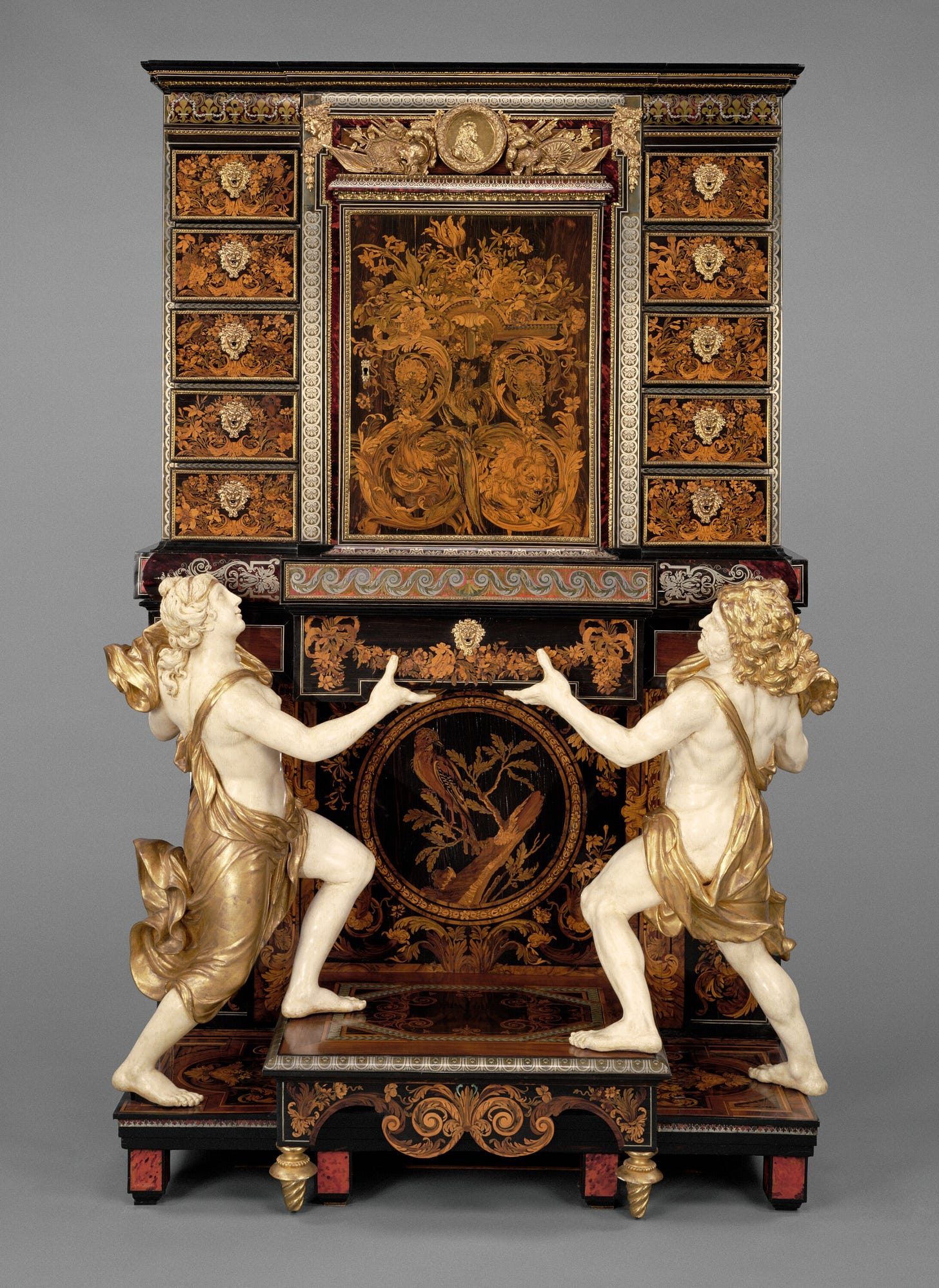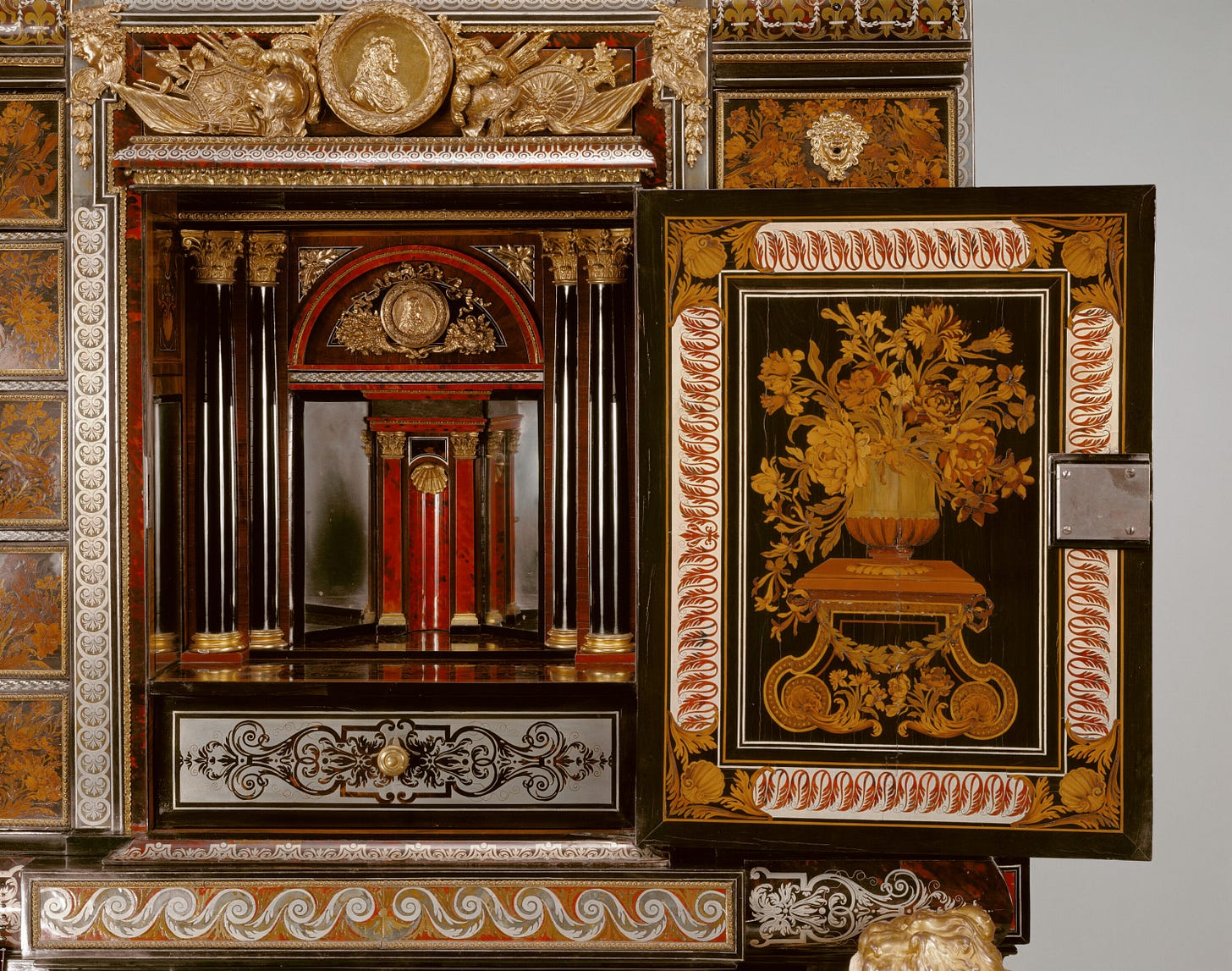Gifts From an Emperor and From God: Louis XIV’s Design Propaganda in the Getty Boulle Cabinet
Chris Suzuki, Art Muse Lecturer
Starting in the mid-seventeenth century King Louis XIV of France sought to remake not only the French state and court, but the entirety of French culture, transforming it into the sparkling crown of Europe with himself as the center jewel. He took direct personal control of all aspects of government as well as the institutions of culture and gears of the economy, famously declaring “I am the State”. Louis created a cult of personality akin to the days of the Caesars, placing himself on the level of the divine and surrounding himself with a court befitting such a station. This was done not just for self aggrandizement—although that is key—but also as a form of soft power, spreading France's influence around the world and creating a legend that endures to this day. A central part of this project was the advancement of the arts and luxury goods in France and no piece better exemplifies this project than the Boulle Cabinet now on display at the Getty Center. Possibly given as a diplomatic gift, it shows every aspect of Louis XIV’s propaganda machine at full strength and the incredible work his artisans like Andre-Charles Boulle and Charles Le Brun were able to achieve at the height of their powers. Louis XIV created an aura around himself that all other monarchs of Europe sought to emulate and using the arts created a personal brand for French royalty that lasts to this day.

Upon coming into his own power in 1661, after a long regency, the young Louis XIV wanted France to be seen as the center of the world and the source of all that was luxurious and fine in it. He saw this as a way to project his and France’s taste and soft power to the world, as well as generate funds for his wars. He wanted the arts to be another branch of his government, directed towards glorifying king and country, and depicting them as sacred, glorious and all powerful. To this end he brought the French Academy under his patronage and founded the Academies of Dance and Opera as well as folding several royal workshops into the Royal Academy of Painting and Sculpture. The last of these he placed under his favorite artist Charles Le Brun who subsequently directed the look of French art and design for decades creating the wonder of Versailles, the high French Baroque, and laying the groundwork for the Academic style.
The king's famed art and finance minister Jean Colbert also played a role in reorganizing the royal furniture workshops, raising standards of production on all French luxury goods, and banning the import of any luxury product that could be made in France. This brought vast sums in the royal coffers and improved the prestige of French products abroad. The King made it a rule that only the finest French clothes could be worn at court, turning the palace into a showroom for French textiles and fashion, and he required the changing of taste twice a year to keep the fabric market humming at a predictable clip. This created the glittering modern court that Louis desired and he invented the fashion magazine with prints to spread the new styles and trends to all the courts of Europe.
These new centralized workshops were located within the Louvre and created a melting pot of techniques, designs, and ideas that drove French arts to new heights. Colbert imported the best artisans from Italy (then the center for art in Europe) to teach French workmen and create the talent pool he needed; then he drove them to create and innovate to the tastes of the king. One of the triumphs of this process was the work of cabinet maker André-Charles Boulle. Called by his contemporaries “the most skillful artisan in Paris” and his work “paintings in wood”, Boulle came from a well known artist family with his father also having been cabinetmaker to the King.
Famous for the veneer work that now bears his name, he took a Florentine craft and raised it to the level of high art. So called “Boulle work” was created by layering turtle shell and brass or pewter to a thin layer of wood, then elaborate arabesque designs were drawn onto the surface and the design cut out with a foot powered frame saw. These parts were then separated and the turtle shell and metal sections layered together like puzzle pieces and glued to grease paper. The design was attached face down to the piece of furniture and the paper washed off revealing the design.
One of the finest examples of this work is known as “Cabinet on stand” or “the Boulle Cabinet” now on view at the Getty Center. Crafted between 1675-1680 the cabinet is a bonanza of gilt work, wood inlay, carving, ivory, pewter, brass, ebony, and turtle shell, flaunting the vast wealth of Louis XIV and his court to all who saw the piece. The animal and floral motifs in the doors, drawers, and base were created with each color made of a different wood, highlighted by (now faded) colored stains. The frames around the drawers are beautifully crafted Boulle work of shell, pewter, and brass with the silver and gilt bronze adornments on the drawers and top sculpted by Jean Varin. A blending of two arts and artists only possible under Colbert and Le Brun’s direction and the workshops they created for the king. This level of adornment, opulence, and detail became synonymous with all the work that came out of the French court and with luxury itself, changing court culture across Europe to the French way, just as Louis desired. He knew this cultural reach was just as central to his and France's power as his military and economic might.

Louis used his design propaganda not just to impress abroad but also to inspire near religious awe in his subjects. He had himself depicted as Alexander the Great, as the Sun god Apollo, as Mars god of War, and as gods divinely chosen representative on earth destined to rule. He said he was Emperor Trajan reborn and had elaborate court rituals constructed around his daily rising, bathing, and eating, turning them all into an adoration of his majesty. This created a mystic around the king and those allowed access to him, increasing the perception of his power. Early in Louis XIV’s reign this imagery was mostly centered around military themes and his victories in battle as depicted abundantly in the Boulle Cabinet.
At the top, above the main door, are gilt bronze military trophies ensconcing a portrait medallion of a twenty-one year old Louis XIV, depicted as if he were a great Roman general. The door itself bears an inlay veneer of the cockerel of France victoriously crushing the eagle of the Holy Roman Empire and the lion of Spain and the Spanish Netherlands. This was a symbolic depiction of the recent Dutch Wars of 1672-1678, where the French had battled the Spanish, the Dutch, and the Holy Roman Empire simultaneously and beaten them all. The cabinet was made in commemoration of the Treaty of Nijmegan, which ended the war, and this design was a boast by Louis of his triumph and a threat to any who would challenge his power.

The piece was executed with exquisite craftsmanship meant to display the king's good taste and French artistic skill. The cabinet is supported by two carved figures, one male and one female, painted white with robes of gold. The woman on the left side is Hippolyta, Queen of the Amazons, and symbolic of bravery in battle; while the man on the right is the hero Hercules, symbol of strength in war, both from Greek mythology. This connects Louis' victories both to the mythic past and to the glories of ancient Greece, the way his depiction at the top connects him to ancient Rome. It places him as the inheritor of both these grand traditions and places France as the new Rome, meant to rule the world through her king the god of the Sun. All of this worked together to create the aura and brand of Louis XIV, visible in everything created for his court and palpable in even the smallest piece.
Today Versailles stands as a symbol of luxury, opulence, and absolute power just as Louis XIV intended it to be, a grand stage for the glorious theatrics of monarchy. It inspired similar palace complexes across Europe, such as at Potsdam in Prussia and the Tsar’s Village in St Petersburg, and the styles that came from the palace workshops continue to be made and imitated today. Contemporary furniture staples like the sofa, the console table, or the desk had their start in the workshops of Colbert and Le Brun. All this speaks to the continued success of the design propaganda instigated by Louis XIV and his dream to make French luxury goods the standard of the world. No piece better exemplifies this success than the Boulle Cabinet at the Getty, and no piece speaks better to the fate of the monarchy either. For this piece, though bearing the fleur de-lis showing it was made for the crown, is found not in Versailles but in California and its twin resides not in France but in Scotland. This happened with the dispersal of all the royal french collections during the revolution and the chaos that followed, scattering the pieces to the winds. Yet at the same time this dispersal further spread the legend of Versailles, its king, and its design aesthetic around the globe, helping to contribute to its continued popularity and myth to this day.



